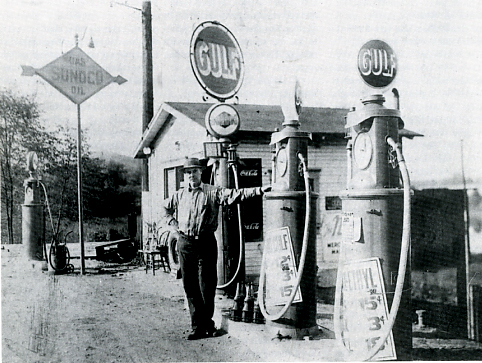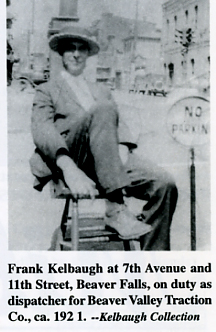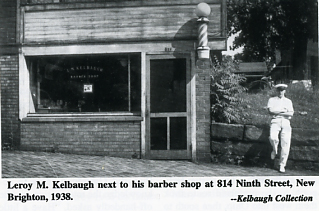
Frank Kelbaugh at his gas station on the West bank of the Beaver River,
between the mouth of Brady's Run and the old Sharon bridge around 1931.
Click Here to Return to Milestones
The second oldest of four boys born to Frank 'Pap" and Mabel 'Mum" Byerle Kelbaugh, Roy Kelbaugh was born in New Brighton and lived there continuously until 1976 when he retired to North Carolina. These are more of the many stories he would tell about the family during his growing up years. (Part 1 - The Early Years appeared in the Autumn 2001 issue of Milestones.)

Early in his career with the Beaver Valley Traction Company, Pap
often served as a dispatcher. In that capacity he sometimes was
stationed at 11th Street and 7th Avenue in Beaver Falls, where
he would issue passenger transfers and regulate the flow of trolleys
through that busy intersection. One particular day while on duty
there he realized he hadn't seen any traffic come north up the
avenue for quite a while. About that time he noticed a crowd gathered
in the middle of the street a block away, and he decided he'd
better see what was happening. As he neared the scene he noticed
the entire intersection was blocked by two horse-and-wagon rigs,
and a crowd of people had gathered around them. Everyone seemed
to be having a great time laughing at what was going on. As he
got closer, Pap realized that the driver of one wagon was Mum's
uncle, Harry McBrien. The other driver was another man he also
recognized. Somehow one wheel of Harry's wagon had become caught
in the trolley tracks in a way that was blocking the other man's
rig. But instead of working to clear the way both drivers stood
in the middle of the street shouting back and forth at each other.
Pap turned to Harry and asked, "What's going on here?"
(According to Dad, Uncle Harry sometimes spoke with a stammer.
And when he got excited the stammer would get worse.) "F-F-F-Frank",
replied Harry, "th-th-th-this guy is making fun of the way
I'm t-t-t-talking!" At that moment Pap realized what had
really happened, for he knew that the other driver also had a
speech impediment. "Harry," he said, "he's not
making fun of you. He has the same speech problem you have! Now
get back up on your wagon and move it out of here. You two have
traffic backed up all the way to the bottom of the hill and we've
got street cars to run!"
About 1920 Pap and Mum bought the house at 701 11th Avenue, New
Brighton, where they raised their four boys and lived out their
remaining years together, until her death in 1963. In those days
the Riverview trolley ran north and south on 10th Avenue, just
a block from the house. Coming from Beaver Falls the trolley crossed
the old 10th Street bridge, took 12th Avenue south to 6th Street,
turned west on 6th to l0th Avenue, then south to 11th Street.
There it headed east to Penn Avenue where it turned south again
to 14th Street, then west again to the old railroad station on
5th Avenue. The return trip reversed that route.
Either by accident or from watching other kids in the neighborhood,
Dad and his younger brother Karl had learned that it was great
fun to put stones onto the trolley tracks then wait for the trolley
to come along and run over them. "Sparks would fly from the
wheels, and if you got good soft stones, they would make the prettiest
sand, and it would spread out all along the track." Dad would
usually prompt young Karl to put the stones in place while he
lay back in the bushes. One day while they were about their mischief,
the motorman saw them in action and recognized them as Frank Kelbaugh's
boys. But the boys didn't realize they had been spotted. When
the trolley reached 7th Avenue and 11th Street in Beaver Falls,
Pap was there, doing his dispatcher duties. The motorman told
him what had happened, and Pap then suggested that the two of
them trade places for the next run, and he would take care of
the problem. The next time the trolley crossed over the bridge
and headed down 10th Avenue, Dad and Karl had their stones lined
up and were waiting nearby. But as the trolley got close to the
stones, the boys were surprised to see it slow down and come to
a stop. They were even more surprised when the motorman got off.
And when they recognized their Pap coming straight toward them,
they went into mild shock! That ended the game, once and for all!
Frank Kelbaugh (1883 - 1965) was born and raised in West Virginia,
the second eldest of eight children. He came to Beaver County
in 1901 at age 18. A year later his mother died, and by 1905 his
father, James W. Kelbaugh (1858 - 1934), left the farm in West
Virginia and brought his six other children to live in New Brighton.
When asked in later years why so many people came to this area
around that time, Dad would explain, "New Brighton was a
boom town then. If a man couldn't get a job in New Brighton, he
couldn't get a job anywhere." Grandpap Jim landed a job as
manager of the New Brighton office of the Metropolitan Life Insurance
Co.

His first house was in the 1800 block of 4th Street, in the Oak Hill section of New Brighton. In due time he started keeping company with Mary Goddard Carpenter, a widow who lived just up the street. Mary also had been born and raised in West Virginia. They were married on Christmas Day 1907. Some time around 1915 Grandpap Jim got sick. His doctor said he thought it was tuberculosis, a killer disease at that time. After thinking about the situation, Grandpap told the family, "Well, if I'm going to die, I want to die on a farm." With that he moved Mary and the children out of town onto a small farm in Chippewa Township. To supplement his income he took a temporary position as schoolmaster for part of one term at the Richmond School, a one-room schoolhouse on Park Road near the intersection with Dutch Ridge Road. During his remaining years he had several different farms in the area known as Brady's Run. (Note: The last of these farms was on Brady's Run Road, near present-day Seven Oaks Country Club, and is currently owned by Mr. and Mrs. M. C. Stout.)

When the great flu epidemic struck the country in the fall of
1918, claiming more than 600,000 lives and making countless others
sick, the Kelbaugh family was not totally spared. Mum and the
three oldest boys - young Jim, Roy and Karl - all come down sick
at the same time. Pap escaped the disease but found himself having
to nurse the entire family, which then included his fourth son,
baby Claire, just six months old. Somehow Pap was able to handle
all the chores himself, except for the cooking. That was taken
care of by neighbors, who delivered their meals to the front porch
and collected the dishes there afterward.
By 1919 Grandpap Jim and members of the extended family were making
frequent trips back to Jackson County, West Virginia, to visit
Grandpap's brothers and sisters who were still living there. Usually
they went by automobile. And in those days of the Model T, few
paved roads, no road maps, frequent flooding, and only scattered
gas stations, it was always a long and adventurous journey taking
12 hours or more. Dad recalled that at least one of those trips
extended over two days.
Roads in the West Virginia panhandle area were particularly poor,
so the preferred route took them west into Ohio, then south to
Belpre, where they could cross the Ohio River bridge into Parkersburg.
Flat tires and over-heated radiators were frequent, and the general
lack of service stations meant most drivers did their own basic
repairs. For Dad and his young brothers this was a source of great
adventure. But for the men it was a lot of work. To patch a tire
involved jacking up the car, pulling the wheel, prying the tire
off the rim to get at the inner tube, locating the leak, "roughing"
the surface around the leak, applying glue to the roughed surface,
quickly and accurately placing a rubber patch, lighting a match
to the area to burn off the excess glue and hopefully provide
a stronger seal, replacing the tube in the tire and the tire to
the rim, refilling the tire with air using a hand pump, remounting
the wheel, lowering the jack, and replacing the tools. Then you
could get back on the road. According to Dad, a half dozen or
more blowouts were about par for a trip to West Virginia, "And
that didn't count the flat tires!"
On one such trip, about 1924, Pap was driving the family, including
Mum, Grandpap, and the four boys - young Jim, Roy, Karl and Claire.
About halfway into the trip they had a flat. Pap pulled over to
the side as best he could and in the heat of a blazing sun proceeded
to make the necessary repair, as described above. While all this
was going on, everyone got out to find some cool spot nearby,
except Grandpap. Well-known for his easy-going disposition - people
today would call him "laid back" - Grandpap, dressed
in his good suit, collar and tie, remained seated in the shade
of the back seat. When the tire was finally fixed, Pap called
the others to get back into the car so they could proceed down
the road. Only then did Grandpap seem to acknowledge the interruption,
and he off-handedly asked, "Have a little trouble, Frank?"

Mary Goddard Kelbaugh, second wife of Grandpap Jim Kelbaugh, had
been married twice previously. Her first husband was a Mr. Bush;
the second was Charles Carpenter. Each of these men was a widower
with young children when she married him, and both men died and
left Mary to finish raising the children. So, this woman who was
married three times and never bore a child of her own, raised
three families of children for three different husbands. Grandma
Mary was known to have a sharp tongue, and occasionally she'd
exercise it on Grandpap Jim. While talking about that to Pap he
once said, "Whenever she gets on me about something, I just
get up and walk out onto the porch. If she follows me there I
go out into the yard. If she follows me there I head on over to
the barn. Sometimes she'll follow me there. But then I just walk
up the hill into the upper pasture; and I know she won't follow
me there." Mary Goddard Bush Carpenter Kelbaugh died on Grandpap
Jim's farm in Brady's Run in November 1932 and is buried in Grove
Cemetery, New Brighton, next to her second and third husbands,
Charles Carpenter and James Kelbaugh.
Dad learned the barber trade after school and on Saturdays while
he was still attending New Brighton High School. His mentor was
Charles VanKirk (1887 - 1959), who later became his father-in-law.
Charlie's shop at that time was in a storefront of the Frederick
building, a wood frame structure on the southeast comer of 9th
Street hill and 8th Avenue. Charlie lived in the same building
in an upstairs apartment with his family, then just his wife Bert
and their twin daughters Christina and Catherine. By 1929 Dad
bought the barber shop from Charlie and moved the business into
another building that still stands, just one door east. The Frederick
building has since been torn down, leaving only a vacant lot.
In those days most retail shops closed at noon on Wednesdays,
but stayed open late on Saturdays to catch the rural customers
who would come to town for their weekly shopping. One Wednesday
in 1925, Charlie left the shop about mid-morning to drive to Beaver
Falls for some sort of business. Dad was to close the shop and
Charlie would return shortly to pick him up, and they would continue
on to Pittsburgh for a day in the city, one of Charlie's favorite
pastimes in those days.

Dad closed the shop according to plan and waited for Charlie to
return. Soon a woman drove up, stopped her car in front of the
shop, and called to him. "Is Mrs. VanKirk at home?"
"Yes, I think she is." "Well, you'd better go get
her; there's been an accident."
Charlie had driven west on 5th Street in New Brighton, and approached
5th Avenue. In those days the main line of the Pittsburgh, Fort
Wayne & Chicago Railroad, later incorporated into the Pennsylvania
Railroad, ran right up the middle of 5th Avenue, Vehicular traffic
on the cross streets was protected by crossing gates and signal
lights. But on this day the gate and signal at 5th Street failed
to work, or Charlie didn't see them. As he attempted to cross
the track, his car was hit broadside by an express passenger train
coming from the south. His automobile was dragged quite a distance
along the track and Charlie was thrown out and seriously injured.
He was taken to Beaver Valley General Hospital on Oak Hill, New
Brighton. There, according to his daughter Tina, he lay virtually
unattended for more than 24 hours because the doctors were convinced
he would not survive his injuries. On the second day, surprised
to find the patient still alive, the doctors ordered that he be
cleaned up so treatment could begin. Charlie recovered from those
injuries, but for the rest of his life he walked with a severe
limp and he often used a cane, particularly in his later years.
During his final illness it was discovered that he had only one
kidney. Presumably the other was a casualty of this accident.